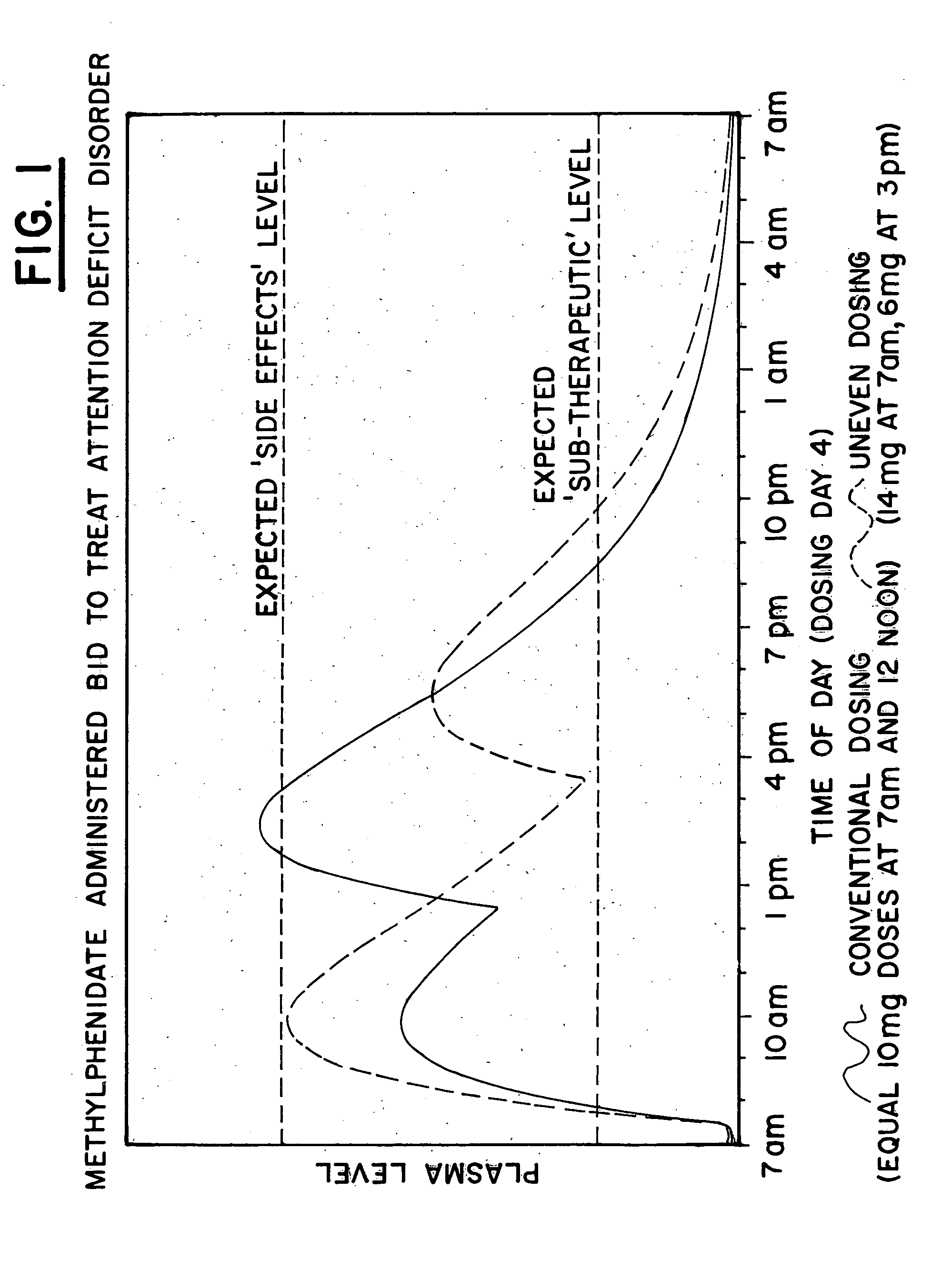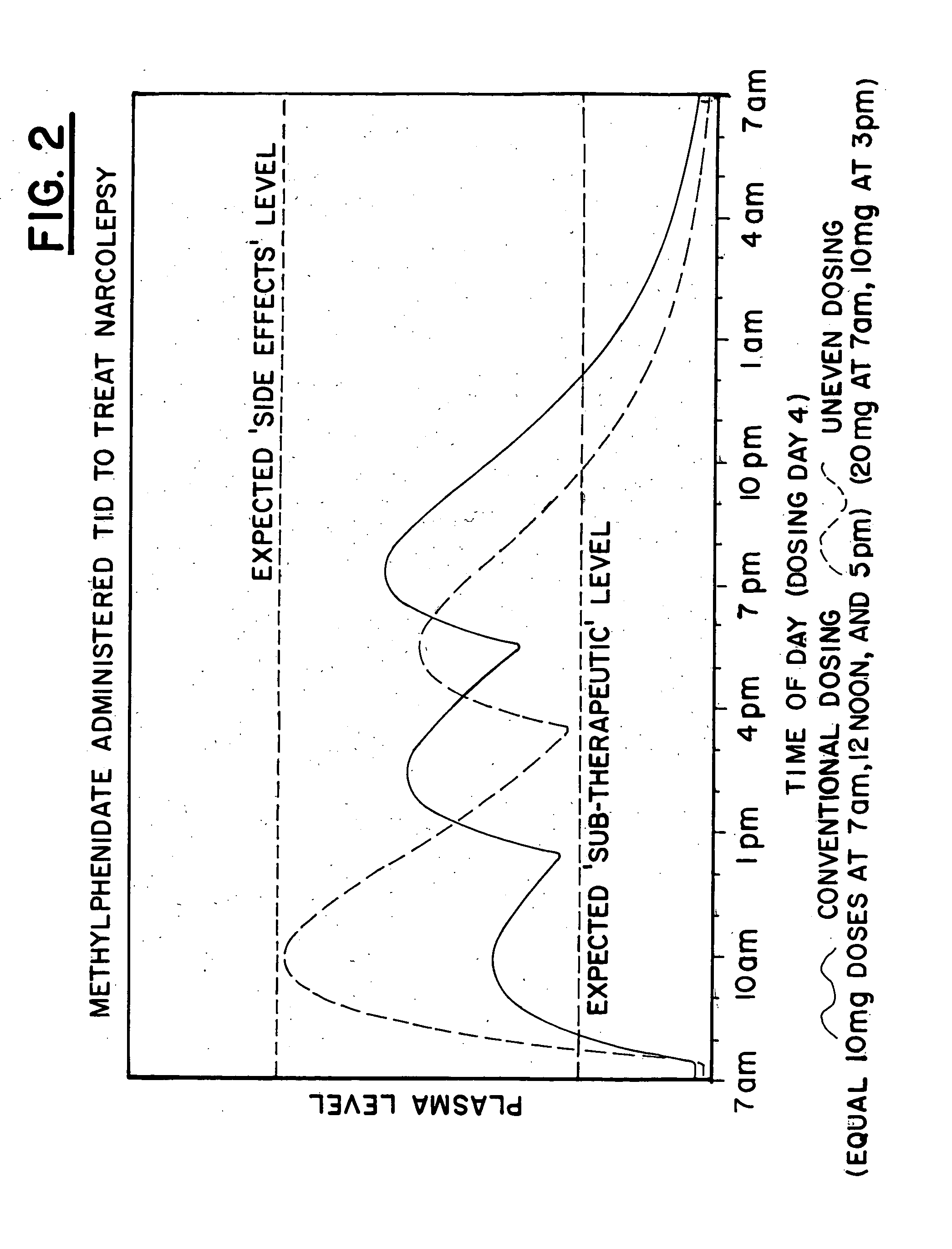Maximizing effectiveness of substances used to improve health and well being
a technology of health and well being, applied in the direction of nitrile/isonitrile active ingredients, organic active ingredients, pharmaceutical delivery mechanisms, etc., can solve the problems of high dosage low level of active therapeutic substances, and generally failing to account for administration effects of current dosage forms
- Summary
- Abstract
- Description
- Claims
- Application Information
AI Technical Summary
Problems solved by technology
Method used
Image
Examples
example i
[0167] The plasma profile for methylphenidate, available from CibaGeneva under the trade name Ritalin.RTM., when administered in a conventional form, 10 mg at 7 am and 10 mg at 12 pm, for the treatment of Attention Deficit Disorder (ADD) was determined based on data available in the medical literature and is illustrated by the solid line in FIG. I. Note that when using the conventional administration, high dosages of the drug would be present in the body throughout the afternoon and early evening, causing over-stimulation of the patient and resultant side effects, such as twitching and convulsions.
[0168] A single dose of 20 mg Ritalin.RTM. was then administered to each of 6 normal adult males. After measuring plasma concentrations of the 6 normal adult males, an exemplary plasma profile for the drug, using uneven dosing, 14 mg at 7 am and 6 mg at 3 pm, was developed with a pharmacokinetic mathematical model, as illustrated by the dashed line in FIG. I. Note that the uneven dosing wi...
example ii
[0169] The plasma profile for methylphenidate, available from CibaGeneva under the trade name Ritalin.RTM., when administered in a conventional form, with 20 mg at 7 am, 10 mg at 12 pm and 10 mg at 5 pm, for the treatment of narcolepsy was determined based on data available in the medical literature and is illustrated by the solid line in FIG. II. Note that when using the conventional administration, lower dosages of the drug are present in the patient during the morning hours when the patient has the greatest difficulty staying awake and increasingly higher dosages of the drug would be present in the body throughout the evening and bedtime hours, resulting in sleeplessness.
[0170] A single dose of 20 mg Ritalin.RTM. was then administered to each of 6 normal adult males. After measuring plasma concentrations of the 6 normal adult males, an exemplary plasma profile for the drug was developed with a pharmacokinetic mathematical model, using uneven dosing, 20 mg at 7 am and 10 mg at 3 p...
example iii
[0171] The plasma profile for vitamin B.sub.12, when administered in conventional form, 12 mcg at 7 am, is illustrated by the solid line in FIG. III. Note that when using the conventional administration, there is virtually no vitamin B.sub.12 present in the patient during the evening and nighttime hours when nerve tissue repair, which is known to require vitamin B.sub.12, predominantly occurs.
[0172] An exemplary plasma profile for vitamin B.sub.12 is set forth using uneven dosing, 4 mcg at 7 am and 8 mcg at 11 pm, as illustrated by the dashed line in FIG. III. Note that the uneven dosing will result in the presence of high levels of vitamin B.sub.12 in the patient during the nighttime hours, when the vitamin is most beneficial to the patient because it is available to assist in the repair of nerve tissue, that may be a result of stroke or other trauma.
PUM
| Property | Measurement | Unit |
|---|---|---|
| time intervals | aaaaa | aaaaa |
| time | aaaaa | aaaaa |
| time | aaaaa | aaaaa |
Abstract
Description
Claims
Application Information
 Login to View More
Login to View More - R&D
- Intellectual Property
- Life Sciences
- Materials
- Tech Scout
- Unparalleled Data Quality
- Higher Quality Content
- 60% Fewer Hallucinations
Browse by: Latest US Patents, China's latest patents, Technical Efficacy Thesaurus, Application Domain, Technology Topic, Popular Technical Reports.
© 2025 PatSnap. All rights reserved.Legal|Privacy policy|Modern Slavery Act Transparency Statement|Sitemap|About US| Contact US: help@patsnap.com



